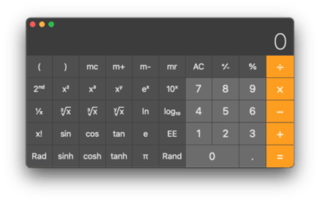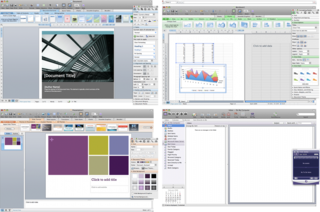Related Research Articles

Microsoft Office, or simply Office, is a family of client software, server software, and services developed by Microsoft. It was first announced by Bill Gates on August 1, 1988, at COMDEX in Las Vegas. Initially a marketing term for an office suite, the first version of Office contained Microsoft Word, Microsoft Excel, and Microsoft PowerPoint. Over the years, Office applications have grown substantially closer with shared features such as a common spell checker, Object Linking and Embedding data integration and Visual Basic for Applications scripting language. Microsoft also positions Office as a development platform for line-of-business software under the Office Business Applications brand.

Be Inc. was an American computer company that created and developed the BeOS and BeIA operating systems, and the BeBox personal computer. It was founded in 1990 by former Apple Computer executive Jean-Louis Gassée, who also served as the company's CEO, and was based in Menlo Park, California.
Macworld/iWorld was an information technology trade show with conference tracks dedicated to Apple's Mac platform. It was held annually in the United States during January. Originally Macworld Expo and then Macworld Conference & Exposition, the gathering dates back to 1985. The conference was organized by International Data Group (IDG), co-publisher of Macworld magazine.
Power Computing Corporation was the first company selected by Apple Inc to create Macintosh-compatible computers. Stephen “Steve” Kahng, a computer engineer best known for his design of the Leading Edge Model D, founded the company in November 1993. Power Computing started out with financial backing from Olivetti and Kahng.
Tasman is a discontinued browser engine developed by Microsoft for inclusion in the Macintosh version of Internet Explorer 5. Tasman was an attempt to improve support for web standards, as defined by the World Wide Web Consortium. At the time of its release, Tasman was seen as the layout engine with the best support for web standards such as HTML and CSS. Internet Explorer for Mac is no longer supported, but newer versions of Tasman are incorporated in some other Microsoft products.
Internet Explorer for Mac was a proprietary web browser developed by Microsoft for the Macintosh platform to browse web pages. Initial versions were developed from the same code base as Internet Explorer for Windows. Later versions diverged, particularly with the release of version 5, which included the cutting-edge, fault-tolerant and highly standards-compliant Tasman layout engine.

Stevenote is a colloquial term for keynote speeches given by Steve Jobs, former CEO of Apple, at events such as the Apple Worldwide Developers Conference, Macworld Expo, and Apple Expo. Because most Apple product releases were first shown to the public at these keynotes, "Stevenotes" caused substantial swings in Apple's stock price.

A Macintosh clone is a computer running the Mac OS operating system that was not produced by Apple Inc. The earliest Mac clones were based on emulators and reverse-engineered Macintosh ROMs. During Apple's short lived Mac OS 7 licensing program, authorized Mac clone makers were able to either purchase 100% compatible motherboards or build their own hardware using licensed Mac reference designs.

Rhapsody is an operating system that was developed by Apple Computer after its purchase of NeXT in the late 1990s. It is the fifth major release of the Mach-based operating system that was developed at NeXT in the late 1980s, previously called OPENSTEP and NEXTSTEP. Rhapsody was targeted to developers for a transition period between the Classic Mac OS and Mac OS X. Rhapsody represented a new and exploratory strategy for Apple, more than an operating system, and runs on x86-based PCs and on Power Macintosh.
The Apple community is a group of people interested in Apple Inc. and its products, who report information in various media. Generally this has evolved into a proliferation of websites, but latterly has also expanded into podcasts, either speculating on rumors about future product releases, simply report Apple-related news stories, or have discussions about Apple's products and how to use them.
Canvas X is a drawing, imaging, and publishing computer program from Canvas GFX for personal computers.

Calculator is a basic calculator application made by Apple Inc. and bundled with its macOS, iOS, and watchOS operating systems. It has three modes: basic, scientific, and programmer. The basic mode includes a number pad, buttons for adding, subtracting, multiplying, and dividing, as well as memory keys. Scientific mode supports exponents and trigonometric functions. The macOS version of Calculator also has a programmer mode that gives the user access to more options related to computer programming.

Microsoft Office 2008 for Mac is a version of the Microsoft Office productivity suite for Mac OS X. It supersedes Office 2004 for Mac and is the Mac OS X equivalent of Office 2007. Office 2008 was developed by Microsoft's Macintosh Business Unit and released on January 15, 2008. Office 2008 was followed by Microsoft Office for Mac 2011 released on October 26, 2010, requiring a Mac with an Intel processor and Mac OS version 10.5 or better. Office 2008 is also the last version to feature Entourage, which was replaced by Outlook in Office 2011. Microsoft stopped supporting Office 2008 on April 9, 2013.

The Mac, short for Macintosh, is a family of personal computers designed and marketed by Apple Inc. The product lineup includes the MacBook Air and MacBook Pro laptops, and the iMac, Mac Mini, Mac Studio, and Mac Pro desktops. Macs are sold with the macOS operating system.
Microsoft Office 98 Macintosh Edition is a version of Microsoft Office for the classic Mac OS, unveiled at Macworld Expo/San Francisco on January 6, 1998. It introduced the Internet Explorer 4.0 browser and Outlook Express, an Internet e-mail client and usenet newsgroup reader. Office 98 was re-engineered by Microsoft's Macintosh Business Unit to satisfy customers' desire for more Mac-like software.
Scott Knaster is an American technical writer who has written many books, mostly dealing with Macintosh programming and using the Macintosh. He has worked for such companies as Apple Inc., General Magic, Microsoft, Danger Inc., and Google.
Two major families of Mac operating systems were developed by Apple Inc.
EditDV was a video editing software released by Radius, Inc. in late 1997 as an evolution of their earlier Radius Edit product. EditDV was one of the first products providing professional-quality editing of the then new DV format at a relatively affordable cost and was named "The Best Video Tool of 1998". Originally EditDV was available for Macintosh only but in February 2000 EditDV 2.0 for Windows was released. With version 3.0 EditDV's name was changed to CineStream.

Mac OS is the series of operating systems developed for the Macintosh family of personal computers by Apple Computer from 1984 to 2001, starting with System 1 and ending with Mac OS 9. The Macintosh operating system is credited with having popularized the graphical user interface concept. It was included with every Macintosh that was sold during the era in which it was developed, and many updates to the system software were done in conjunction with the introduction of new Macintosh systems.
Comparison of user features of operating systems refers to a comparison of the general user features of major operating systems in a narrative format. It does not encompass a full exhaustive comparison or description of all technical details of all operating systems. It is a comparison of basic roles and the most prominent features. It also includes the most important features of the operating system's origins, historical development, and role.
References
- 1 2 Jon Fortt (March 25, 2008). "Microsoft looks to cash in on the iPhone". Fortune: Big Tech Blog. Archived from the original on March 27, 2012. Retrieved 2008-04-03.
- ↑ "Explore our teams". Careers.microsoft.com. Retrieved 19 December 2018.
- 1 2 Oliver, Sam (April 2, 2009). "Microsoft optimistic about Office making its way to iPhone". AppleInsider. Retrieved 2010-08-30.
- 1 2 Microsoft (January 7, 1997). "Microsoft Announces New Macintosh Product Unit". Microsoft press release. Retrieved 2007-02-09.
- ↑ "Microsoft 2010 form 10-K". United States Securities and Exchange Commission. 2010-07-30. p. 8. Retrieved 2010-08-05.
- ↑ Dalrymple, Jim (10 January 2006). "MWSF: Microsoft, Apple ink new agreement". Macworld.com. Archived from the original on 2014-10-03.
- ↑ Microsoft (December 18, 2002). "Microsoft Appoints Seasoned Leader as Macintosh Business Unit General Manager". Microsoft press release. Retrieved 2007-02-09.
- ↑ Craig Eisler (June 8, 2007). "Hello from the new General Manager of the Macintosh Business Unit - Craig Eisler". Blogs.msdn.com. Retrieved 2007-06-10.
- ↑ Foley, Mary Jo. "Former Microsoft MacBU chief now running entertainment client software". ZDNet. Retrieved 19 December 2018.
- ↑ "Microsoft replaces Mac GM with 12-year veteran". Macworld. 31 October 2008. Retrieved 19 December 2018.
- ↑ Microsoft (October 2006). "Internet Explorer for Mac no longer available for download". Microsoft.com. Archived from the original on 2007-03-03. Retrieved 2007-03-04.
- ↑ Peter Cohen (August 7, 2006). "WWDC: Microsoft kills Virtual PC for Mac". Macworld. Archived from the original on 2007-10-14. Retrieved 2007-03-04.
- ↑ Fried, Ina (March 11, 2005). "Microsoft to kill MSN for the Mac". ZDNet. CBS Interactive. Retrieved 2010-08-30.